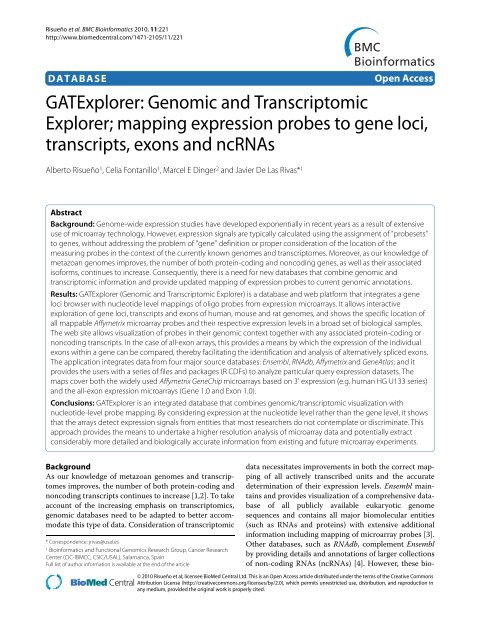Alberto Risueño Pérez - Gredos - Universidad de Salamanca
Alberto Risueño Pérez - Gredos - Universidad de Salamanca
Alberto Risueño Pérez - Gredos - Universidad de Salamanca
You also want an ePaper? Increase the reach of your titles
YUMPU automatically turns print PDFs into web optimized ePapers that Google loves.
<strong>Risueño</strong> et al. BMC Bioinformatics 2010, 11:221<br />
http://www.biomedcentral.com/1471-2105/11/221<br />
DATABASE<br />
BioMed Central<br />
Open Access<br />
Database GATExplorer: Genomic and Transcriptomic<br />
Explorer; mapping expression probes to gene loci,<br />
transcripts, exons and ncRNAs<br />
<strong>Alberto</strong> <strong>Risueño</strong> 1, Celia Fontanillo 1, Marcel E Dinger 2 and Javier De Las Rivas* 1<br />
Abstract<br />
Background: Genome-wi<strong>de</strong> expression studies have <strong>de</strong>veloped exponentially in recent years as a result of extensive<br />
use of microarray technology. However, expression signals are typically calculated using the assignment of "probesets"<br />
to genes, without addressing the problem of "gene" <strong>de</strong>finition or proper consi<strong>de</strong>ration of the location of the<br />
measuring probes in the context of the currently known genomes and transcriptomes. Moreover, as our knowledge of<br />
metazoan genomes improves, the number of both protein-coding and noncoding genes, as well as their associated<br />
isoforms, continues to increase. Consequently, there is a need for new databases that combine genomic and<br />
transcriptomic information and provi<strong>de</strong> updated mapping of expression probes to current genomic annotations.<br />
Results: GATExplorer (Genomic and Transcriptomic Explorer) is a database and web platform that integrates a gene<br />
loci browser with nucleoti<strong>de</strong> level mappings of oligo probes from expression microarrays. It allows interactive<br />
exploration of gene loci, transcripts and exons of human, mouse and rat genomes, and shows the specific location of<br />
all mappable Affymetrix microarray probes and their respective expression levels in a broad set of biological samples.<br />
The web site allows visualization of probes in their genomic context together with any associated protein-coding or<br />
noncoding transcripts. In the case of all-exon arrays, this provi<strong>de</strong>s a means by which the expression of the individual<br />
exons within a gene can be compared, thereby facilitating the i<strong>de</strong>ntification and analysis of alternatively spliced exons.<br />
The application integrates data from four major source databases: Ensembl, RNAdb, Affymetrix and GeneAtlas; and it<br />
provi<strong>de</strong>s the users with a series of files and packages (R CDFs) to analyze particular query expression datasets. The<br />
maps cover both the wi<strong>de</strong>ly used Affymetrix GeneChip microarrays based on 3' expression (e.g. human HG U133 series)<br />
and the all-exon expression microarrays (Gene 1.0 and Exon 1.0).<br />
Conclusions: GATExplorer is an integrated database that combines genomic/transcriptomic visualization with<br />
nucleoti<strong>de</strong>-level probe mapping. By consi<strong>de</strong>ring expression at the nucleoti<strong>de</strong> level rather than the gene level, it shows<br />
that the arrays <strong>de</strong>tect expression signals from entities that most researchers do not contemplate or discriminate. This<br />
approach provi<strong>de</strong>s the means to un<strong>de</strong>rtake a higher resolution analysis of microarray data and potentially extract<br />
consi<strong>de</strong>rably more <strong>de</strong>tailed and biologically accurate information from existing and future microarray experiments.<br />
Background<br />
As our knowledge of metazoan genomes and transcriptomes<br />
improves, the number of both protein-coding and<br />
noncoding transcripts continues to increase [1,2]. To take<br />
account of the increasing emphasis on transcriptomics,<br />
genomic databases need to be adapted to better accommodate<br />
this type of data. Consi<strong>de</strong>ration of transcriptomic<br />
* Correspon<strong>de</strong>nce: jrivas@usal.es<br />
1 Bioinformatics and Functional Genomics Research Group, Cancer Research<br />
Center (CiC-IBMCC, CSIC/USAL), <strong>Salamanca</strong>, Spain<br />
Full list of author information is available at the end of the article<br />
data necessitates improvements in both the correct mapping<br />
of all actively transcribed units and the accurate<br />
<strong>de</strong>termination of their expression levels. Ensembl maintains<br />
and provi<strong>de</strong>s visualization of a comprehensive database<br />
of all publicly available eukaryotic genome<br />
sequences and contains all major biomolecular entities<br />
(such as RNAs and proteins) with extensive additional<br />
information including mapping of microarray probes [3].<br />
Other databases, such as RNAdb, complement Ensembl<br />
by providing <strong>de</strong>tails and annotations of larger collections<br />
of non-coding RNAs (ncRNAs) [4]. However, these bio-<br />
© 2010 <strong>Risueño</strong> et al; licensee BioMed Central Ltd. This is an Open Access article distributed un<strong>de</strong>r the terms of the Creative Commons<br />
Attribution License (http://creativecommons.org/licenses/by/2.0), which permits unrestricted use, distribution, and reproduction in<br />
any medium, provi<strong>de</strong>d the original work is properly cited.
















